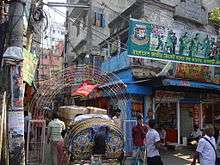Shankhari Bazaar

Shankhari Bazaar (শাঁখারী বাজার) is one of the oldest areas in Old Dhaka (Purana Dhaka). It stretches along a narrow lane, lined with richly decorated brick buildings, built during the late Mughal or Colonial period.
Location
Shankhari Bazar is located near the intersection of Islampur Road and Nawabpur Road, a block north of the Buriganga River. The place especially belongs to the Hindu peoples.
Background and the name
The area belonged to the Shankhari Community, who borrowed their name from Shankha, a decorated bangle crafted from slices of Shankha or conch shells. Shankha is the symbol that indicates that a Hindu woman is married. In the 17th century the Shankhari people were brought by the Mughal emperor, who allotted this place to them for living which later known as Shankhar Bazaar.
Lifestyle of the Shankhari people
The Shankhari people are an artisan caste. Most belong to the Vaishnava branch of Hinduism, and some to the Shakta school; many are vegetarian.[1]
Houses


Shnakhari Bazar was very famous and expensive during the 18th century. The Shankhari people were allotted with places to build houses. Shankhari Bazar is a long narrow street lined by brick buildings which are very old. The widths of buildings were about 12 ft, 70–100 ft in length and 2-3 storeys in height. The highest height of the buildings was four storeys. Every house used to have a temple room in it.
Temples and Durga Puja
The Hindu Temples are one of the major attractions of Shankhari Bazar. There are many temples on this narrow street. Over the ages Shankhari Bazaar has been elevated to the level of the most popular centre for religious festivities. As one of the most densely populated areas in the world Shankhari Bazaar also has the largest concentration of the Hindus in Dhaka. The temples are small in size but well decorated with ornamental motifs on the entrance and on the walls of the temples. The temples contain the statue of goddess Durga, Ganesha, Shiva etc. Durga Puja is the major festival of Hindu people. During Durga puja, people gathers in Shankhari Bazaar to worship and view goddess Durga. Besides Hindu, Muslims also attend the Puja. In Durga puja, Shankhari Bazaar looks quite nice because of colorful feston, banner etc. Small and temporary food shops are also built during Durga puja. People from different places come to Shankhari Bazaar to see the Puja.
Pannitola

Pannitola is in the RAKHALCHANDRABOSHD LANE of Shankhari Bazaar. The name Pannitola basically came from the first settling area of the Panniwala, people who used to make the foil of tin. The living style of the Panniwala's was similar to the Shankhari people.
Shankhari Bazar at present
Over the years, Shankhari Bazaar has lost much of its beauty due to urbanization and negligence from the part of the authorities concerned to protect its archaeological exquisiteness.
References
- ↑ Sharmin Naaz (2012). "Shankhari (shell artisan)". In Sirajul Islam and Ahmed A. Jamal. Banglapedia: National Encyclopedia of Bangladesh (Second ed.). Asiatic Society of Bangladesh.
- Dhaka Shriti Bismritir Nagari, Author: Muntasir Mamun, Published by Ananna Publications | 3rd Edition, January 2004.
Further reading
- Bahauddin, Md (11 March 2011). "Conservation and Management of Historic Buildings: Advanced International Training Programme" (PDF).
- Islam, Taimur; Zaman, Homaira (21 April 2006). "Conservation of a Historic Mohalla". Star Weekend (The Daily Star).
- Glassie,Henry; TRADITIONAL ART of BANGLADESH; Bangla Academy(First Bangladesh Edition:May 2000); Page no:307-313; ISBN 984-07-3929-8.
- Mamun,Muntasir; DHAKA:SMRITI BISMRITIR NAGARI(part 1); Ananya publication(Fourth Edition:January 2004); Page no:248-251; ISBN 984-412-104-3.
- BANGLAPEDIA:BANGLADESH JATIO GYANKOSH(khondo 9); Bangladesh Asiatic Society(First Revised Edition:March 2004);Page no:249-251,274-276; ISBN 984-32-0590-1.
Coordinates: 23°42′36″N 90°24′35″E / 23.709995°N 90.409683°E